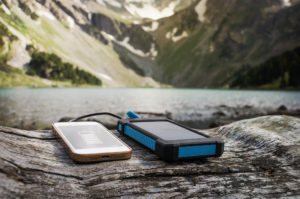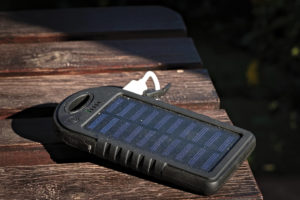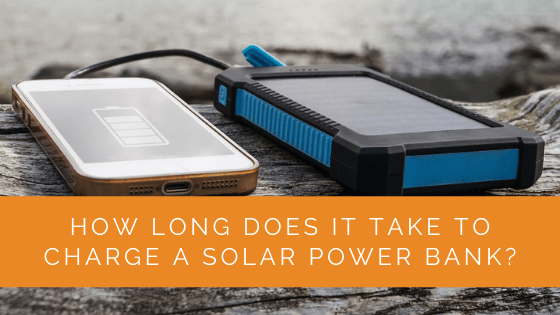Solar power banks prove to be very handy devices when you need to be off-grid for a long time.
Be it cycling, hiking, or camping trips — solar power banks perfectly cater to outdoor charging requirements. Despite their environment-friendliness, users often overlook their functionality.
This brings us to the question — how long does it take to charge a solar power bank?’
A 25000 mAh solar power bank takes about 50 hours to charge with direct sunlight.
However, that is just a rough estimate. The actual numbers might vary based on factors such as the brand and weather.
So, before you set forth on your outdoor trip, let’s figure out the charging time for solar power banks.
Contents
- 1 Key Takeaways
- 2 How Does a Solar Power Bank Work?
- 3 What Time of the Day is Best to Charge Solar Power Banks?
- 4 How Long Do Solar Power Banks Take to Charge in Direct Sunlight?
- 5 Solar Power Bank Charging Time Calculator
- 6 How Many Times Can I Charge My Phone With a Fully Charged Solar Power Bank?
- 7 How to Tell if Solar Panels Have Charged?
- 8 How Can You Speed Solar Power Bank Charging?
- 9 Expert Insights From Our Solar Panel Installers About Charging Solar Power Banks
- 10 Wrapping Up
Key Takeaways
- A 25000 mAh solar power bank takes about 50 hours to charge with direct sunlight, but the actual time may vary based on factors like brand and weather.
- Solar power banks use solar panels to generate energy for charging, and they work best during the early hours of the day when light energy is at its peak.
- The number of times you can charge your device with a fully charged solar power bank depends on the capacities of both the device and the solar bank, and additional solar panels can speed up the charging process.
How Does a Solar Power Bank Work?
Solar energy is one of the best ways to charge your devices. Solar power banks have made it possible for device owners to charge their devices outdoors through renewable energy.
Typically, a solar power bank has a solar panel set up to charge its rechargeable battery. This PV cell is sandwiched between semi-conductive materials.
The manufacturers alter silicon by adding phosphorus on one side, creating a negative charge. On the other side of the panel is the boron, which creates a positive charge. As a result, this generates an electrical field.
The electric field activates the electrons within the cells. Therefore, solar panels use a combination of principles to produce energy for solar power banks.
What Time of the Day is Best to Charge Solar Power Banks?
To recharge the battery of your solar power bank, you have to ensure that there is proper sunlight. The intensity of the sun varies depending on the season and time of the day.
However, you should know that solar panels do not use the sun’s heat to charge. So, just because that mercury level seems to be at its highest doesn’t mean it’s the ideal time to charge.
Light energy is at its best during the early hours of the day.
Extreme temperatures can affect the performance of solar panels. So, keep in the sunshine before it gets too hot in the day.

How Long Do Solar Power Banks Take to Charge in Direct Sunlight?
There’s no denying the fact that solar power banks charge best under direct sunlight. You might not observe much efficiency on a cloudy, rainy, or snowy day.
Also, solar power banks come in different sizes and capacities. Since the battery sizes vary, it also affects the charge time. Generally, manufacturers indicate the battery size in terms of milliampere-hours (mAh).
For instance, a solar power bank might have a size of 25000 mAh. Many factors play a role in determining the exact charge time of your solar power bank.
The table below will give you a brief idea of different capacity power banks and their charge times:
| Power Bank | Number of Panels Required | Charge Time |
|---|---|---|
| 5000 mAh power bank | One solar panel | 6 hours |
| 10000 mAh power bank | Two solar panel | 12 hours |
| 25000 mAh power bank | Five solar panel | 30 hours |
| 30000 mAh power bank | Six solar panel | 36 hours |
| 50000 mAh power bank | Ten solar panel | 60 hours |
| 75000 mAh power bank | Fifteen solar panel | 90 hours |
| 90000 mAh power bank | Eighteen solar panel | 108 hours |
Though the charge times of solar panels and grids have a significant difference, solar power banks are suitable for many reasons.
Solar power banks are an excellent option for outdoor trips as they do not rely on conventional power sources.
Solar Power Bank Charging Time Calculator
Estimate how long it takes to fully charge your solar power bank in direct sunlight.
Estimates are approximate and depend on sunlight conditions, panel quality, and system efficiency.
How Many Times Can I Charge My Phone With a Fully Charged Solar Power Bank?
The number of times you can charge your device depends on the capacities of both the device and the solar bank.
Phones or tablets with higher mAh will require more energy output. As a result, they will consume more energy per charge. If your solar power bank has a low mAh value, it might not be able to give you many charge cycles.
As per the general norm, a 25000 mAh power bank can charge an iPhone 3 to 4 times.
How to Tell if Solar Panels Have Charged?
Solar power banks are similar to regular power banks in many ways. LED lights on either side of the solar power bank act as charge indicators.
When all the lights turn on, the charge level is 100%. However, the solar power bank will work equally well on half the charge too. You don’t need to wait for the power bank to reach 100% to use it.
How Can You Speed Solar Power Bank Charging?
The charge time for solar power banks, even in optimum sunlight conditions, is still slow. In such cases, you might want to look for ways to speed up the charging of your solar power bank.
Here are some suggestions that’ll help you reduce the charge time of your solar power bank:

Additional Panels
Typically, Solar power banks with a greater number of panels take less time to charge. For example, consider two solar panels that have a 25000 mAh capacity. The first 25000 mAh power bank has three solar panels while the other has two.
Which one do you think will charge faster?
Multiple solar PV panels offer more surface area for the photons to strike. As a result, the generated electricity increases.
So, the solar power bank with three panels will charge much faster than the two-panel one.
Considering this, adding a solar panel to your solar power bank is the best solution. Thankfully, most solar power banks in the market come with a decent number of solar panels.
Optimize Conditions
Optimizing conditions is one of the most obvious ways to amp up the charging speed of your solar power bank.
Try to keep the solar power bank in direct sunlight whenever possible. Also, avoid shade as it limits the efficiency of solar panels.
You can keep optimizing the positioning of your solar panel depending on the sunlight.
If you are on the move, make sure you place it on your backpack in a suitable position.
Expert Insights From Our Solar Panel Installers About Charging Solar Power Banks
Charging a solar power bank efficiently requires understanding its capacity and the amount of sunlight available. Ensuring your power bank is in direct sunlight during peak hours can significantly reduce charging time.
Senior Solar Installer
Solar power banks are a great solution for outdoor enthusiasts. The key to their effectiveness is positioning them properly to maximize sunlight exposure, especially during early morning hours when light intensity is optimal.
Lead Solar Technician
Adding additional solar panels can greatly enhance the charging speed of your solar power bank. More surface area means more energy absorption, which translates to faster charging times.
Solar System Engineer
Wrapping Up
Charging power banks that use solar energy can be time-consuming. However, you need not worry as the charge time does not affect the device’s performance.
So, make sure to charge them for at least two days before you set out on an outdoor adventure.
It is best to check with the manufacturer for the exact charge time. We hope this article was able to answer all your questions about charging solar power banks!
About the Author
Solar Panels Network USA stands at the forefront of solar energy solutions, driven by a team of seasoned solar engineers and energy consultants. With over decades of experience in delivering high-quality solar installations and maintenance, we are committed to promoting sustainable energy through customer-centric, tailored solutions. Our articles reflect this commitment, crafted collaboratively by experts to provide accurate, up-to-date insights into solar technology, ensuring our readers are well-informed and empowered in their solar energy decisions.

